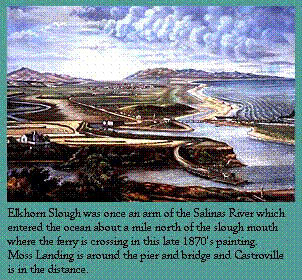River Mouths, Brakish and Estuarine Coastal Wetlands
VI. Humans and the DryingLandscape
 Freshwater drainages, including river mouths, represent the most endangered
ecosystem in the Monterey Bay area and throughout much of central and southern
California (Naiman et al. 1995). The number of endangered and other special
status species is an indicator of the ecosystem problem, but the extensive
ditching and loss of freshwater habitat is a more obvious measure of its
endangered status (Franklin 1993, Orians 1993).
Freshwater drainages, including river mouths, represent the most endangered
ecosystem in the Monterey Bay area and throughout much of central and southern
California (Naiman et al. 1995). The number of endangered and other special
status species is an indicator of the ecosystem problem, but the extensive
ditching and loss of freshwater habitat is a more obvious measure of its
endangered status (Franklin 1993, Orians 1993).
Despite the endangered ecosystem status of MBNMS coastal wetlands, the Monterey Bay region is recognized as one of 18 major biodiversity hot spots on the planet (Wilson 1995). Though the number of endangered and other special status species is highest in the coastal scrub and chaparral plant communities, the restoration of freshwater habitats and communities will have the most significant regional positive impact on biodiversity due to the simultaneous enhancement of wildlife corridors, as well as aquifer recharge and water quality (Naiman et al 1995). The latter two are directly linked to increased water retention along wet corridors, which promotes growth of dense plant communities forming a retention and recharge sponge. The restored wet corridor holds more water for a longer period, and provides the most effective water quality filter in the watershed (Hammer and Bastian 1989).
The last 150 years of severe degradation of MBNMS watersheds has had several direct impacts on marine habitats. Rivers transport less sand into the bay; consequently, many MBNMS beaches are eroding (Arnal et al. 1975, Griggs 1987, McGrath 1987; and see Geology section). Wet corridors support relatively little vegetation, and therefore transport much less wood and other organic debris to the intertidal and subtidal beach environment. This in turn decreases erosion protection and wrack habitats for coastal wildlife. Without the cleansing filters of dense plant communities, many rivers are highly turbid, reducing plankton production and thus food for animals in the river mouths and adjacent offshore habitats. Freshwater corridors collect worrisome urban and agricultural chemicals and transport these to river sinks, particularly the estuarine lagoons at the river mouths, and then into the nearshore marine environment (Oakden and Oliver 1990, Ladd et al. 1984, Watkins et al. 1984).
While these problems are significant, none is more widespread and of greater impact than the loss of fresh water and the tremendous decrease in water resource values in the watersheds of Monterey Bay. These values include surface water retention, groundwater recharge, flood control, water quality, fire protection and biodiversity (Watershed Institute 1996).
| < Previous Section V. Animals |
||
